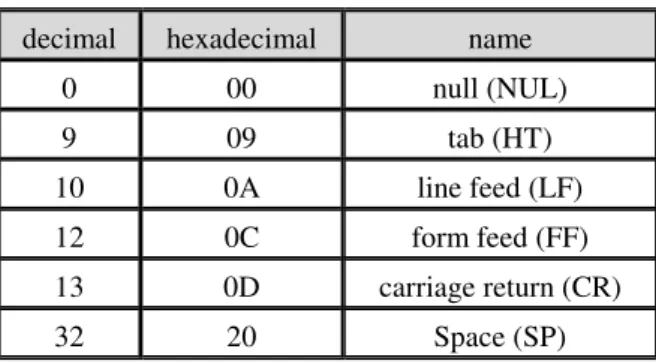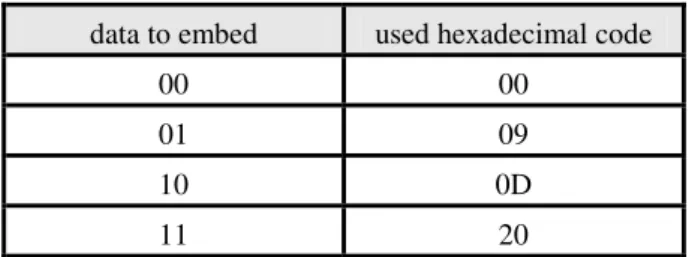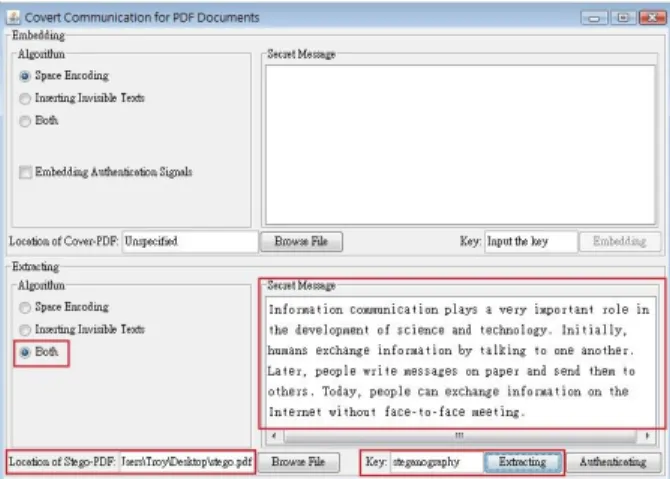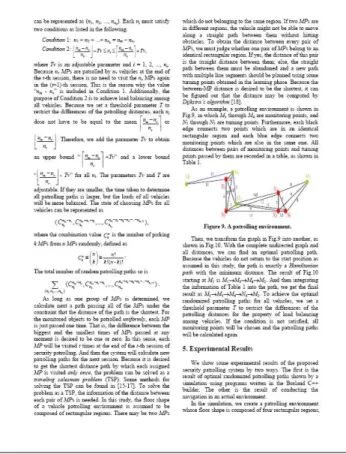COVERT COMMUNICATION VIA PDF FILES BY NEW DATA HIDING TECHNIQUES*
1
Yin-Cheng Lai (賴以晟) and
2Wen-Hsiang Tsai (蔡文祥)
Department of Computer Science, National Chiao Tung University, Hsinchu, Taiwan E-mail: 1troy0420.cs96g@g2.nctu.edu.tw, 2whtsai@cs.nctu.edu.tw
ABSTRACT
PDF files become very popular nowadays. People use them to exchange information on the Internet, and so it is also a good choice to use PDF files as cover media for covert communication. A method for this purpose by two new data hiding techniques is proposed. The first is a technique based on a white space coding using space- equivalent codes in the PDF file. And the second is a technique of inserting invisible texts into PDF files via the use of artificially created text matrices outside the visible area of the displayed PDF document. A secret key is used to enhance the security of the embedded data.
Experimental results show the feasibility of the proposed method.
1. INTRODUCTION
Many kinds of file formats can be used in information communication. The PDF (portable document format) is one of the most common formats and has become more and more popular nowadays because of its advantages in various applications, such as high printing quality and cross-platform applicability.
In addition to using PDF files directly to exchange information, it is also advantageous to use them as cover media to hide data for secret message transmission and other uses. Although PDF files are popular now, there are yet not many researches on data hiding in PDF files.
It is desirable to have more kinds of data hiding techniques for various application purposes.
Several techniques for data hiding in PDF files have been proposed in recent years [2-5]. Zhong and Chen [2] proposed an information steganography algorithm on PDF documents by hiding data between indirect objects of PDF documents. The algorithm can embed data of unlimited lengths into PDF documents and the embedded PDF documents are kept transparent when being displayed in PDF readers. Zhong, Cheng and Chen [3] proposed a steganographic technique for hiding data in a kind of PDF English texts. They modified integer numerals which are used to position
∗ This work was supported by NSC project No. 97-2631- H-009-001.
characters in the PDF text. Because the perceptual difference is very small, people cannot be aware of the hidden data in the PDF document. Liu et al. [4]
proposed an algorithm based on equivalent transformations in PDF files. They discovered that the effect of the page display of a PDF file is extraneous to the seriation of the dictionary’s entries so that data hiding can be achieved by arranging special arrays of entries, instead of by operations of adding any other data to the cover PDF. Wang and Tsai [5] proposed a data hiding method by slight modifications of the values of various PDF object parameters, yielding a difference of appearance difficult to notice by human vision.
In this paper, we propose two data hiding techniques via PDF files for secret transmission. The first is based on a white space coding scheme. When opening a PDF file with a certain text editor, we can see the initial code of the PDF file, in which there are many white-space characters used to separate syntactic constructs from one another. According to the PDF standard [1], many distinct characters are treated as white-space characters. We can use this property to embed secret messages. The second technique is based on a scheme of inserting invisible texts into a cover PDF.
In a PDF file, a text matrix decides where and how to display the corresponding text in a PDF document. We may insert some specially-specified text matrices with their coordinates being outside the visible area of the PDF so that the corresponding text, where secret messages are embedded, will not show on the displayed PDF documents, thus achieving the effect of data hiding or steganography.
In the remainder of this paper, we give first a general introduction to the PDF in Section 2. In Section 3, we describe the proposed secret transmission method via PDF files by two different kinds of data hiding techniques. And in Section 4, some experimental results are shown. A conclusion is made in Section 5.
2. INTRODUCTION TO PDF
The Adobe portable document format (PDF) is one of the Adobe® Acrobat® family of products [1] and is described by a page description language which is modified from PostScript®. Each PDF file represents a
document in a manner independent of the application software, hardware, and operating systems used to create the document and of the output device on which the document is to be displayed or printed. The basic elements in a PDF file are objects that together describe the appearance of one or more pages of the PDF document. A PDF document’s pages can contain any combination of text, graphics, and images, and a PDF page’s appearance is determined by a content stream which contains a sequence of graphics objects to be painted on the page.
According to the PDF standard [1], a canonical PDF file initially consists of four parts (see Figure 1) as follows.
1. A one-line header identifying the version of the PDF specification to which the file conforms.
2. A body consists of a sequence of indirect objects representing the contents of the PDF document.
3. A cross-reference table containing information about the indirect objects in the PDF file, such as the offset of each object which give the object’s location in the displayed document.
4. A trailer giving the location of the cross-reference table and those of certain special objects within the body of the file.
Fig. 1. Structure of a PDF file.
In a PDF file, white-space characters are used to separate syntactic constructs from one another.
According to the PDF standard, many distinct characters are treated as white spaces. Table 1 shows this property of the PDF. All white-space characters are equivalent, except in comments, strings, and streams. We can use this property to embed secret messages into PDF files, as done in this study. More details will be described in Section 3.1.
A text matrix in an indirect object of a PDF file is used to set the state of the corresponding text and locate it. The structure of a text matrix is as follows:
a b c d e f Tm
where a through f are all numbers and “Tm” is the operator of the text matrix. The first four numbers a, b, c and d are used for describing text scaling, rotation, and skew. The initial values are 1, 0, 0 and 1, respectively.
The other two numbers e and f are the distances to translate the origin of the coordinate system used for PDF document display in the horizontal and vertical dimensions, respectively. In this paper, we use the numbers e and f to embed secret messages. More details will be described in Section 3.2.
Table 1. White-space characters in PDF files.
decimal hexadecimal name
0 00 null (NUL)
9 09 tab (HT)
10 0A line feed (LF)
12 0C form feed (FF)
13 0D carriage return (CR)
32 20 Space (SP)
3. DATA HIDING TECHNIQUES FOR SECRET TRANSSMISSION VIA PDF FILES
3.1 Data Hiding in PDF Files by White Space Coding According to Table 1, a white-space character may described by one of six different codes, namely, the hexadecimal number 00, 09, 0A, 0C, 0D, or 20. After some experiments, we found out in this study that in some text editors, 0C will show as a line and 0A will cause line feeding, in the displayed document of a PDF file containing these two codes. If we use these two codes to embed secret messages, people will be aware of the existence of the hidden data easily by inspecting the displayed PDF document. So we only use 00, 09, 0D and 20 to embed the secret message in this study.
Furthermore, we know that all white-space characters are equivalent except in comments, strings, and streams, so if 00, 09, 0D and 20 are not in comments, strings, and streams, they all usable to embed secret messages.
Accordingly, we can embed two bits of message data using a single usable white-space character. That is, we can use 00, 09, 0D and 20 to represent the 2-bit message data 00, 01, 10, and 11, respectively. Table 2 shows this scheme, which we call white-space coding.
Table 2. Proposed data embedding scheme.
data to embed used hexadecimal code
00 00
01 09
10 0D
11 20
For example, if the secret message is 0011011110, we use five white space characters to embed the message and the codes of them are 00, 20, 09, 20, and 0D, representing the in-order bit pairs 00, 11, 01, 11, and 10 in the secret, respectively.
Besides, in order to tell how many white-space characters have been modified for data hiding, we use two bytes to represent the length of the secret message and embed them into the PDF file before embedding the secret message data. These two bytes will be used in the message data recovery process.
Since we do not insert any other data into the cover PDF in the above-described message data embedding process, the size of the PDF file will not change. And so it is difficult for a reader of the displayed stego-PDF document to be aware of the existence of the hidden data in the PDF file. But obviously, the capacity of the data which are embed, called data embedding capacity in the sequel, is limited by the number of the usable white- space characters that the cover PDF have.
3.2 Data Hiding in PDF Files by Insertion of Invisible Texts
In this section, the other proposed data hiding technique based on a scheme of inserting invisible texts into a cover PDF is described. The basic idea is that we embed into the PDF file some text matrices whose coordinates are outside the visible area of the PDF so that the corresponding texts will not be shown on the displayed PDF document.
In more detail, given a secret message in the form of a bit string, we transform it, three bits a time, into decimal numbers and process them to define the values of e and f in a number of text matrices. The transformation scheme is specified by Table 3. After the transformation, the secret data become a long string of decimal digits, which we regard as a big integer number and denote as N. Then we process N to define e and f for some text matrices according to the following steps.
1. Create a text matrix M1 and set e of it as N if N does not cause an overflow, and set f of it as 0.
2. If N causes an overflow, first separate N into two numbers N1 and N2, where N1 is taken to be the leading decimal digits in N which together as an integer do not cause an overflow, and N2 to be the
remaining decimal digits in N. And then take e of M1
as N1 and f of M2 as N2 if N2 does not cause an overflow.
3. If N2 causes an overflow, then separate N2 into two numbers N21 and N22 in a similar way so that N21 are the leading decimal digits in N2 which together as an integer do not cause an overflow, and then take N21
to be f of M1, leaving N22 to be processed in the next step.
4. Create a second text matrix M2, and repeat the above three steps recursively using N22 as input, until all the remaining decimal digits in N22 are exhausted.
Note that the range and precision of numbers are limited by the internal representations used in the computer on which the PDF consumer application is running. So when we define the values e and f of the created text matrices using decimal digits in the original N in the above process, overflows might occur. The result of the above recursive process is several text matrices which include all the decimal digits of N as their values of e and f.
In a PDF document, each page of the document is represented by a page object—a dictionary that includes references to the page’s contents and other attributes.
Each page object has a parameter named MediaBox which defines the boundaries of the physical medium on which the page is intended to be displayed or printed. In short, the MediaBox decides the visible area of the page.
A common visible area of a PDF page is 595×842. In order to guarantee that the position of the text in a text matrix is outside the visible area to create invisibility to an observer of the displayed PDF document, we concatenate “999” before the decimal numbers of e and f of each created text matrix. An example is given as follows.
Suppose the secret message is “010001110.”
According to Table 3, we transform it into a string of decimal digits “327.” Then, we prefix “999” to it to yield N = 999327. Finally, we create a text matrix and put N in it according to the previously-described secret message embedding process. The final text matrix is as shown below:
1 0 0 1 999327 0 Tm.
Table 3. Transformation between binary message string and decimal numbers.
bit segment decimal number bit segment decimal number
000 1 100 5
001 2 101 6
010 3 110 7
011 4 111 8
After we insert message data into the cover PDF file in the above way, the offset of each indirect object and the offset of the cross-reference table in the file may change. Such changes may cause a wrong display of the resulting PDF document. So we have to update the cross-reference table and the trailer of the PDF file to get a correct stego-PDF file. More specifically, suppose that we embed the secret message in an indirect object B to get B′. Since we insert additional data in B, the size of B′ is bigger than B. Therefore, the offsets of the indirect objects whose locations are behind B need to be updated by increasing them for a value D which is the difference of the size between B and B′. And if the cross-reference table is also behind B, the trailer needs to be updated by the same way, too.
Since the embedded data will not appear in the displayed PDF document, the data embedding capacity is unlimited, but at the cost of increasing the size of the resulting stego-PDF file.
3.3 Proposed Data Hiding Algorithm
We have proposed two data hiding techniques via PDF files. We may use only either of them or both for secret transmission. For the latter case, if the secret message is short enough, then the first technique suffices to embed all the message data into the cover PDF; or if we cannot embed data just by the first technique, then the second technique is used further to embed the remaining data. The detail is described below as an algorithm.
Algorithm 1: embedding a message in a PDF file.
Input: a user key K, a secret message S, and a cover PDF file P.
Output: a stego-PDF file P′.
Steps:
1. Encrypt S by a certain method with K (for example, by the DES algorithm), to get encrypted secret data S′ and let l be the length of it in bytes.
2. Count the number m of all usable white-space characters in P and compute the embedding capacity n in bytes as n = m/4.
3. Separate S′ into two parts S1 and S2 by the following way.
3.1 If n ≥ l+2, take S1to be a string composed of S′
and prefixed by its length l (expressed as two bytes), and take S2 to be null.
3.2 Else, take S1 to be a string composed of the first n − 2 bytes of S′ and prefixed by its length n − 2 (expressed as two bytes), and take S2 to be the remaining bytes of S′.
4. Embed S2 into P in the following way if S2 is not null.
4.1 Transform S2 into a bit sequence and pad S2
with one or two zeros, if necessary, to make the number of bits in the resulting string S2′ a triple of an integer.
4.2 Divide S2′ into 3-bit segments g1, g2, …, gk, and map g1, g2, …, gk into decimal numbers g1′, g2′, …, gk′, respectively, according to Table 3.
4.3 Embed g1′ through gk′ into P one by one by the scheme of inserting invisible texts, as described in Section 3.2.
5. Embed S1 into P in the following way.
5.1 Transform S1 into a bit sequence S1′.
5.2 Divide S1′ into 2-bit segments f1, f2…, f4w, where w denotes the length of original S1 in bytes.
5.3 Embed f1, f2, …, f4w into P one by one by the scheme of white space coding, as described in Section 3.1.
6. Update the cross-reference table and trailer, if needed, to get a stego-PDF file P′ as output.
3.4 Proposed Data Recovery Algorithm
The proposed data recovery process is described as follows, which corresponds to Algorithm 1.
Algorithm 2: recovering a secret message from a stego-PDF file.
Input: a user key K and a stego-PDF file P′.
Output: the secret message S hidden in P′.
Steps:
1. Find the first eight usable white-space characters in P′ and decode them according to Table 2 to get two bytes of data which contains the number n of the characters embedded in P′ by the scheme of white space coding.
2. Find the subsequent n usable white space characters in P′, h1, h2…, hn.
3. Transform h1 through hn into binary pairs according to Table 2, and concatenate them to get secret data S1. 4. Scan P′ and find out all the text matrices embedded
in P′ by the scheme of inserting invisible texts by detecting the existence of the prefix “999” in the value e of each checked matrix.
5. Extract sequentially the decimal numbers g1, g2…, gk from the values of e and f in the text matrices found in the last step.
6. Transform g1 through gk into 3-bit segments according to Table 3, and concatenate them to get secret data S2.
7. Concatenate S1 and S2 to get secret data S′.
8. Decrypt S′ with the input key K to recover the desired secret message S.
4. EXPERIMENTAL RESULTS
In order to implement the proposed method for covert communication, we designed a user interface written in the language of Java. It supports the following three ways to hide and recover secret messages:
1. using the proposed white space coding technique only;
2. using the proposed technique of inserting invisible texts only;
3. using the proposed method of combining the two techniques together.
In our experiments, we used the combined method of the third way above. Some results of our experiments are shown in Figures 2 through 6. Figure 2 shows the window of the user interface with a secret message and a user key as input, which mean that the user embeds the secret message in a cover PDF by the proposed combined method. The result of the secret recovery with a correct user key is shown in Figure 3. The cover PDF is shown in Figure 4 and the stego-PDF is shown in Figure 5. Comparing the two figures, no change can be seen on the displayed PDF documents. In addition, Figure 6 shows the result of the secret recovery with an incorrect user key.
5. CONCLUSIONS
In this paper, two different data hiding techniques via PDF files and a method for covert communication by combining the two techniques have been proposed. The first technique is based on a white space coding using codes in the PDF file which appear to be white spaces.
The second a technique inserts invisible texts into PDF files via the use of artificially created text matrices which appear outside the visible area of the displayed PDF document and so are invisible to the observer of the document. Secret keys are used to enhance the security of the embedded data.
The data embedding capacity of the first data hiding technique is limited by the number of usable white-space characters in the cover PDF while the size of the cover PDF will not change after data embedding because we do not insert any other data in it. The data embedding capacity of the second technique is unlimited so that we can embed a large amount of secret data. If the secret message is short enough, we may just use the first technique; else, the second technique is used subsequently to embed the remaining secret data.
No matter which technique or both are uses to implement covert communication, it has no influence on the display of the PDF file so that people cannot be aware of the existence of the hidden data. Even if an illicit user knows that there is a secret message in the PDF file, the covert message can be protected by a user key, and the illicit user still cannot extract the original secret message. The proposed methods are feasible, as proved by the good experimental results.
Future researches may be directed to applying the proposed data embedding techniques to other information hiding applications, like copyright protection by watermarking, secret authentication, information sharing, etc.
REFERENCES
[1] Adobe Systems Incorporated, PDF Reference, Sixth Edition, Addison-Wesley, California, USA, Nov. 2006.
[2] S. Zhong and T. Chen, “Information steganography algorithm based on PDF documents,” Computer Engineering, vol. 32, no. 3, pp. 161-163, Feb.
2006.
[3] S. Zhong, X. Cheng and T. Chen, “Data hiding in a kind of PDF texts for secret communication,”
International Journal of Network Security, vol. 4, no. 1, pp. 17-26, January 2007.
[4] X. Liu et al., “A steganographic algorithm for hiding data in PDF files based on equivalent transformation,” Proc. of 2008 International Symposiums on Information Processing, pp. 417- 421, Moscow, Russia, May 23-25, 2008.
[5] J. T. Wang and W. H. Tsai, “Data hiding in PDF files and applications by imperceptible modifications of PDF object parameters,” Proc. of 2008 Conf. on Computer Vision, Graphics &
Image Proc., Yilan, Taiwan, Aug. 24-26, 2008.
Figure 2. Window of user interface.
Figure 3. The result of secret recovery with correct user key.
Figure 4. A cover PDF.
Figure 5. The stego-PDF of the cover PDF of Fig. 4.
Figure 6. Result of secret recovery with incorrect key.



